width TOYOTA TUNDRA 2017 2.G Owners Manual
[x] Cancel search | Manufacturer: TOYOTA, Model Year: 2017, Model line: TUNDRA, Model: TOYOTA TUNDRA 2017 2.GPages: 588, PDF Size: 10.76 MB
Page 214 of 588
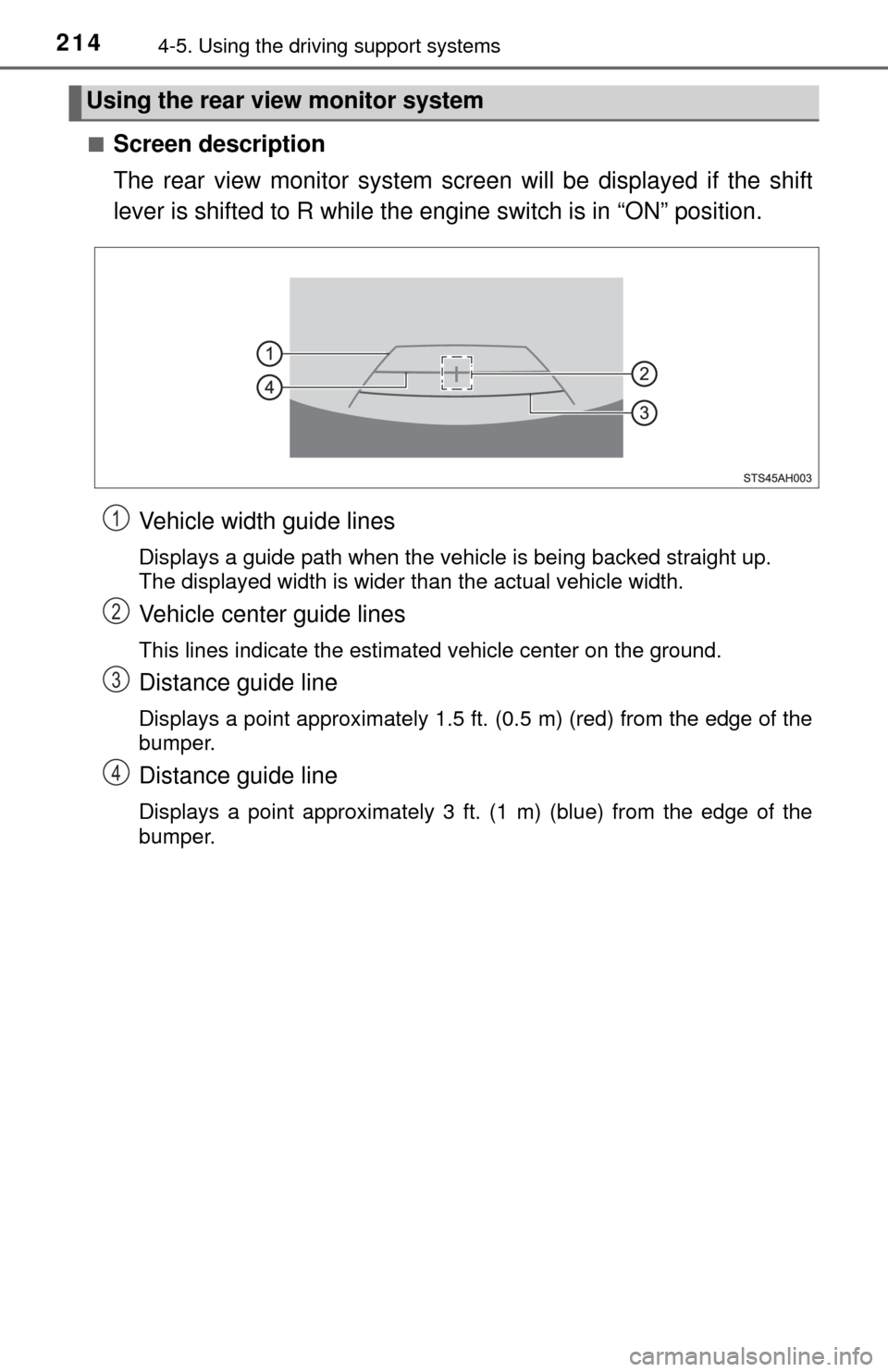
2144-5. Using the driving support systems
■Screen description
The rear view monitor system scr een will be displayed if the shift
lever is shifted to R while the eng ine switch is in “ON” position.
Vehicle width guide lines
Displays a guide path when the vehicle is being backed straight up.
The displayed width is wider than the actual vehicle width.
Vehicle center guide lines
This lines indicate the estimated vehicle center on the ground.
Distance guide line
Displays a point approximately 1.5 ft. (0.5 m) (red) from the edge of the
bumper.
Distance guide line
Displays a point approximately 3 ft. (1 m) (blue) from the edge of the
bumper.
Using the rear view monitor system
1
2
3
4
Page 216 of 588

2164-5. Using the driving support systems
●Using the camera
If dirt or foreign matter (such as water droplets, snow, mud, etc.) is
adhering to the camera, it cannot transmit a clear image. In this
case, flush it with a large quantity of water and wipe the camera
lens clean with a soft and wet cloth.
■Differences between the screen and the actual road
The distance guide lines and the v ehicle width guide lines may not
actually be parallel with the dividi ng lines of the parking space, even
when they appear to be so. Be sure to check visually.
The distances between the vehicle width guide lines and the left
and right dividing lines of the parking space may not be equal, even
when they appear to be so. Be sure to check visually.
The distance guide lines give a distance guide for flat road sur-
faces. In any of the following situations, there is a margin of error
between the fixed guide lines on the screen and the actual dis-
tance/course on the road.
● When the ground behind the vehicle slopes up sharply
The distance guide lines will
appear to be closer to the vehi-
cle than the actual distance.
Because of this, objects will
appear to be farther away than
they actually are. In the same
way, there will be a margin of
error between the guide lines
and the actual distance/course
on the road.
Page 217 of 588
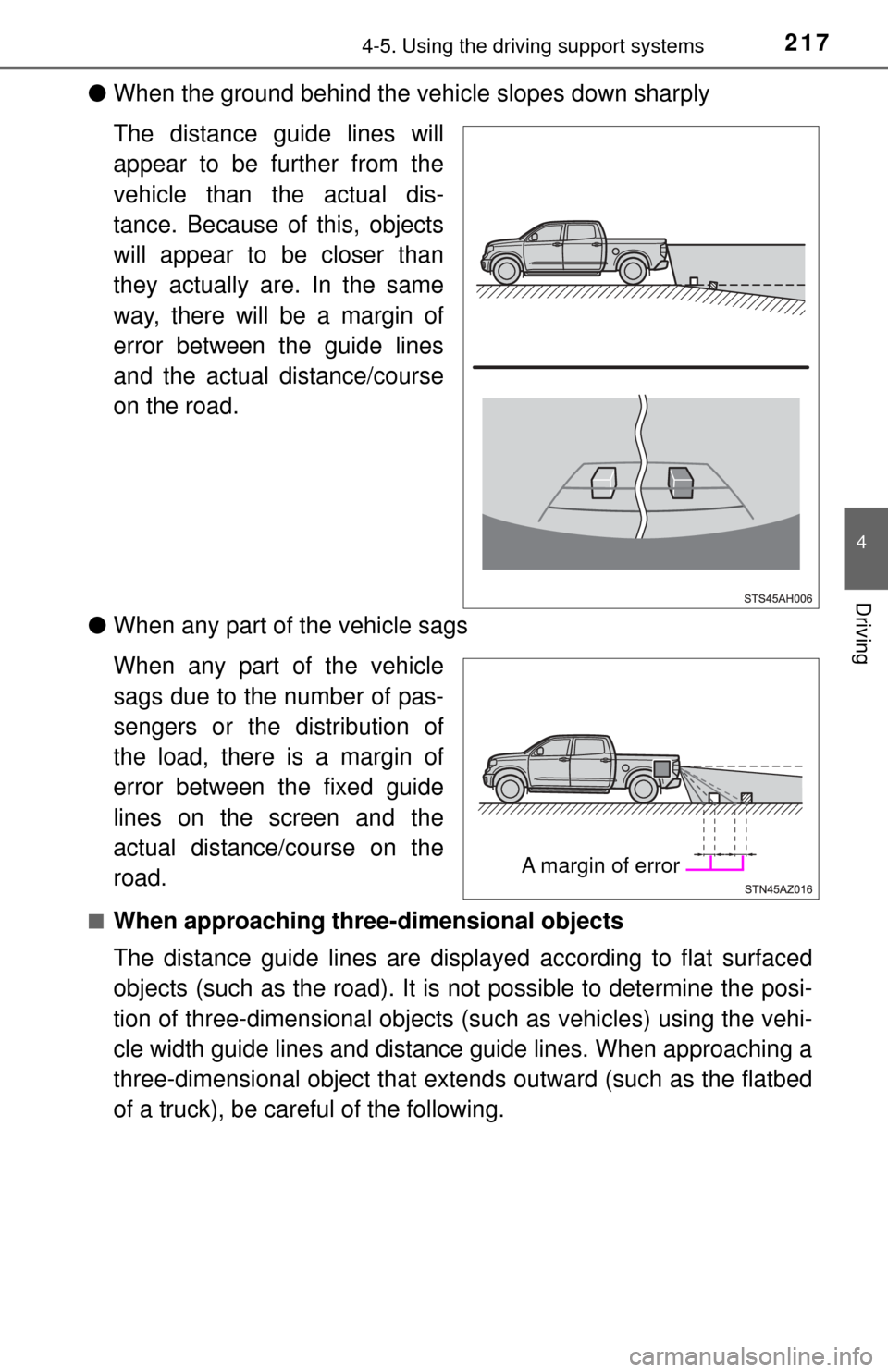
2174-5. Using the driving support systems
4
Driving
●When the ground behind the vehi cle slopes down sharply
The distance guide lines will
appear to be further from the
vehicle than the actual dis-
tance. Because of this, objects
will appear to be closer than
they actually are. In the same
way, there will be a margin of
error between the guide lines
and the actual distance/course
on the road.
● When any part of the vehicle sags
When any part of the vehicle
sags due to the number of pas-
sengers or the distribution of
the load, there is a margin of
error between the fixed guide
lines on the screen and the
actual distance/course on the
road.
■When approaching thre e-dimensional objects
The distance guide lines are displayed according to flat surfaced
objects (such as the road). It is not possible to determine the posi-
tion of three-dimensional objects (s uch as vehicles) using the vehi-
cle width guide lines and distance guide lines. When approaching a
three-dimensional object that extends outward (such as the flatbed
of a truck), be careful of the following.
A margin of error
Page 218 of 588
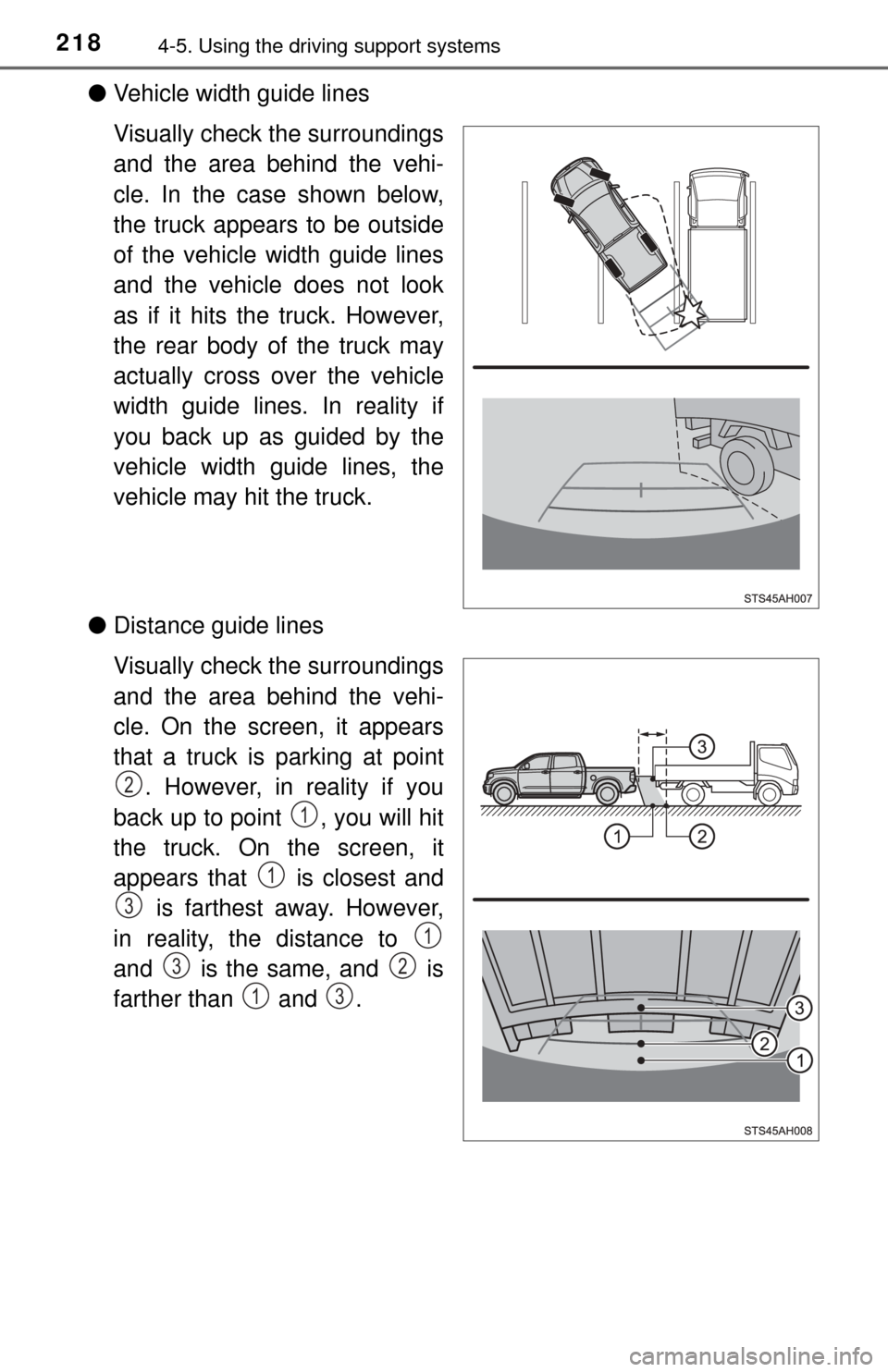
2184-5. Using the driving support systems
●Vehicle width guide lines
Visually check the surroundings
and the area behind the vehi-
cle. In the case shown below,
the truck appears to be outside
of the vehicle width guide lines
and the vehicle does not look
as if it hits the truck. However,
the rear body of the truck may
actually cross over the vehicle
width guide lines. In reality if
you back up as guided by the
vehicle width guide lines, the
vehicle may hit the truck.
● Distance guide lines
Visually check the surroundings
and the area behind the vehi-
cle. On the screen, it appears
that a truck is parking at point
. However, in reality if you
back up to point , you will hit
the truck. On the screen, it
appears that is closest and is farthest away. However,
in reality, the distance to
and is the same, and is
farther than and .
2
1
1
3
1
32
13
Page 437 of 588

4377-3. Do-it-yourself maintenance
7
Maintenance and care
Wheels
When replacing wheels, care should be taken to ensure that they are
equivalent to those removed in load capacity, diameter, rim width and
inset
*.
Replacement wheels are available at your Toyota dealer.
*: Conventionally referred to as “offset”.
Toyota does not recommend using the following:
● Wheels of different sizes or types
● Used wheels
● Bent wheels that have been straightened
● Use only Toyota wheel nuts and wrenches designed for use with
your aluminum wheels.
● When rotating, repairing or changi ng your tires, check that the
wheel nuts are still tight after driving 1000 miles (1600 km).
● Be careful not to damage the aluminum wheels when using tire
chains.
● Use only Toyota genuine balance we ights or equivalent and a plas-
tic or rubber hammer when balancing your wheels.
If a wheel is bent, cracked or heavily corroded, it should be
replaced. Otherwise, the tire may separate from the wheel or
cause a loss of handling control.
Wheel selection
Aluminum wheel precautions (if equipped)
Page 510 of 588
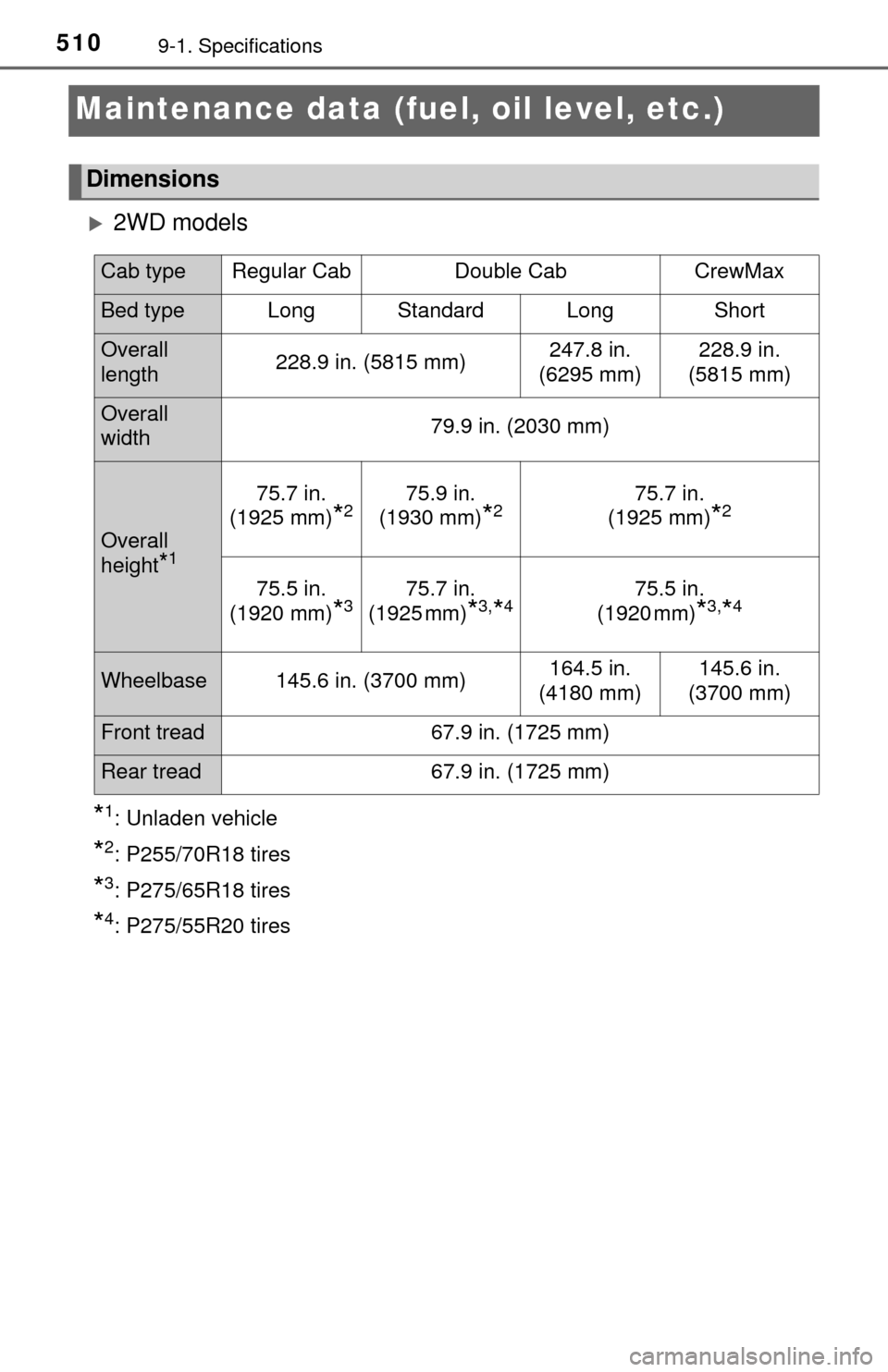
5109-1. Specifications
Maintenance data (fuel, oil level, etc.)
2WD models
*1: Unladen vehicle
*2: P255/70R18 tires
*3: P275/65R18 tires
*4: P275/55R20 tires
Dimensions
Cab type Regular Cab Double Cab CrewMax
Bed type Long Standard Long Short
Overall
length228.9 in. (5815 mm) 247.8 in.
(6295 mm) 228.9 in.
(5815 mm)
Overall
width 79.9 in. (2030 mm)
Overall
height
*1
75.7 in.
(1925 mm)
*275.9 in.
(1930 mm)
*275.7 in.
(1925 mm)
*2
75.5 in.
(1920 mm)
*375.7 in.
(1925 mm)
*3,*475.5 in.
(1920 mm)
*3,*4
Wheelbase 145.6 in. (3700 mm) 164.5 in.
(4180 mm) 145.6 in.
(3700 mm)
Front tread 67.9 in. (1725 mm)
Rear tread 67.9 in. (1725 mm)
Page 511 of 588
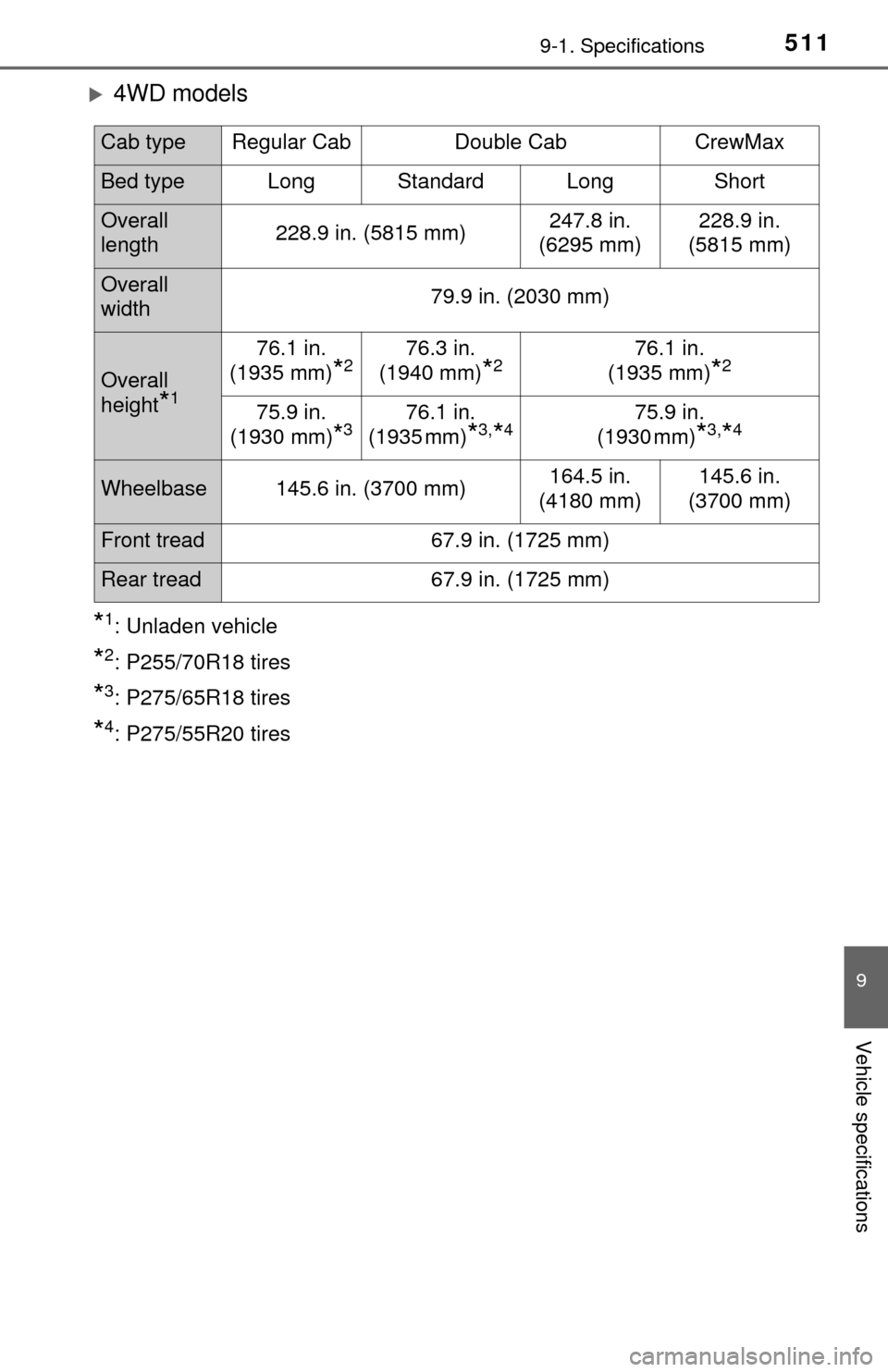
5119-1. Specifications
9
Vehicle specifications
4WD models
*1: Unladen vehicle
*2: P255/70R18 tires
*3: P275/65R18 tires
*4: P275/55R20 tires
Cab type Regular Cab Double CabCrewMax
Bed type Long Standard Long Short
Overall
length228.9 in. (5815 mm) 247.8 in.
(6295 mm) 228.9 in.
(5815 mm)
Overall
width 79.9 in. (2030 mm)
Overall
height
*1
76.1 in.
(1935 mm)
*276.3 in.
(1940 mm)
*276.1 in.
(1935 mm)
*2
75.9 in.
(1930 mm)
*376.1 in.
(1935 mm)
*3,*475.9 in.
(1930 mm)
*3,*4
Wheelbase 145.6 in. (3700 mm) 164.5 in.
(4180 mm) 145.6 in.
(3700 mm)
Front tread 67.9 in. (1725 mm)
Rear tread 67.9 in. (1725 mm)
Page 534 of 588

5349-1. Specifications
DOT symbol*
Tire Identification Number (TIN)
Tire manufacturer’s identification mark
Tire size code
Manufacturer’s optional tire type code (3 or 4 letters)
Manufacturing week
Manufacturing year
Manufacturer’s code
*: The DOT symbol certifies that the tire conforms to applicable Federal Motor Vehicle Safety Standards.
■
Typical tire size information
The illustration in dicates typical
tire size.
Tire use
(P = Passenger car,
T = Temporary use)
Section width (millimeters)
Aspect ratio
(tire height to section width)
Tire construction code
(R = Radial, D = Diagonal)
Wheel diameter (inches)
Typical DOT and Tire Identification Number (TIN)
Ty p e AType B
Tire size
1
2
3
4
5
6
7
8
1
2
3
4
5
Page 535 of 588
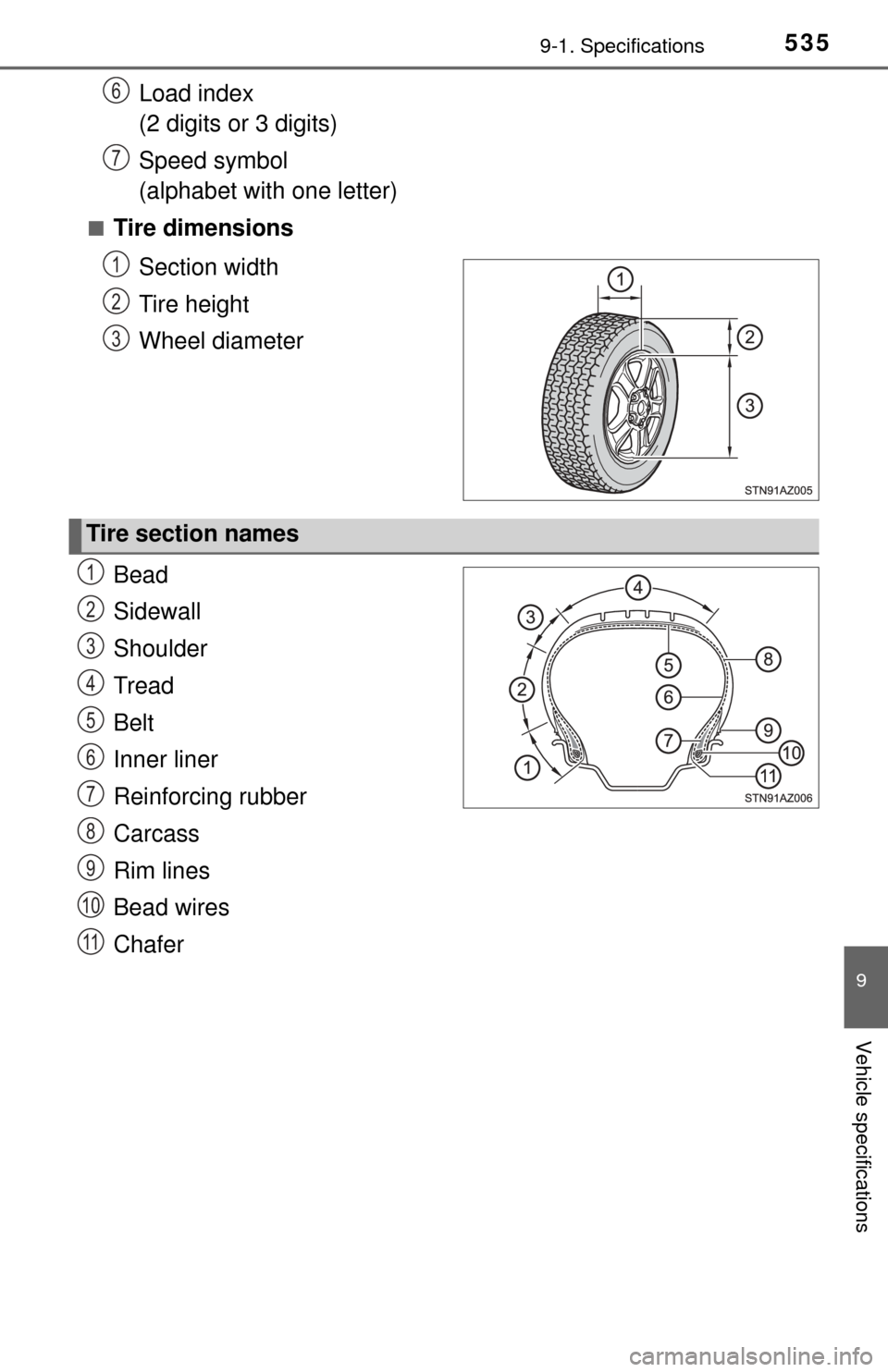
5359-1. Specifications
9
Vehicle specifications
Load index
(2 digits or 3 digits)
Speed symbol
(alphabet with one letter)
■Tire dimensionsSection width
Tire height
Wheel diameter
Bead
Sidewall
Shoulder
Tread
Belt
Inner liner
Reinforcing rubber
Carcass
Rim lines
Bead wires
Chafer
6
7
1
2
3
Tire section names
1
2
3
4
5
6
7
8
9
10
11
Page 536 of 588
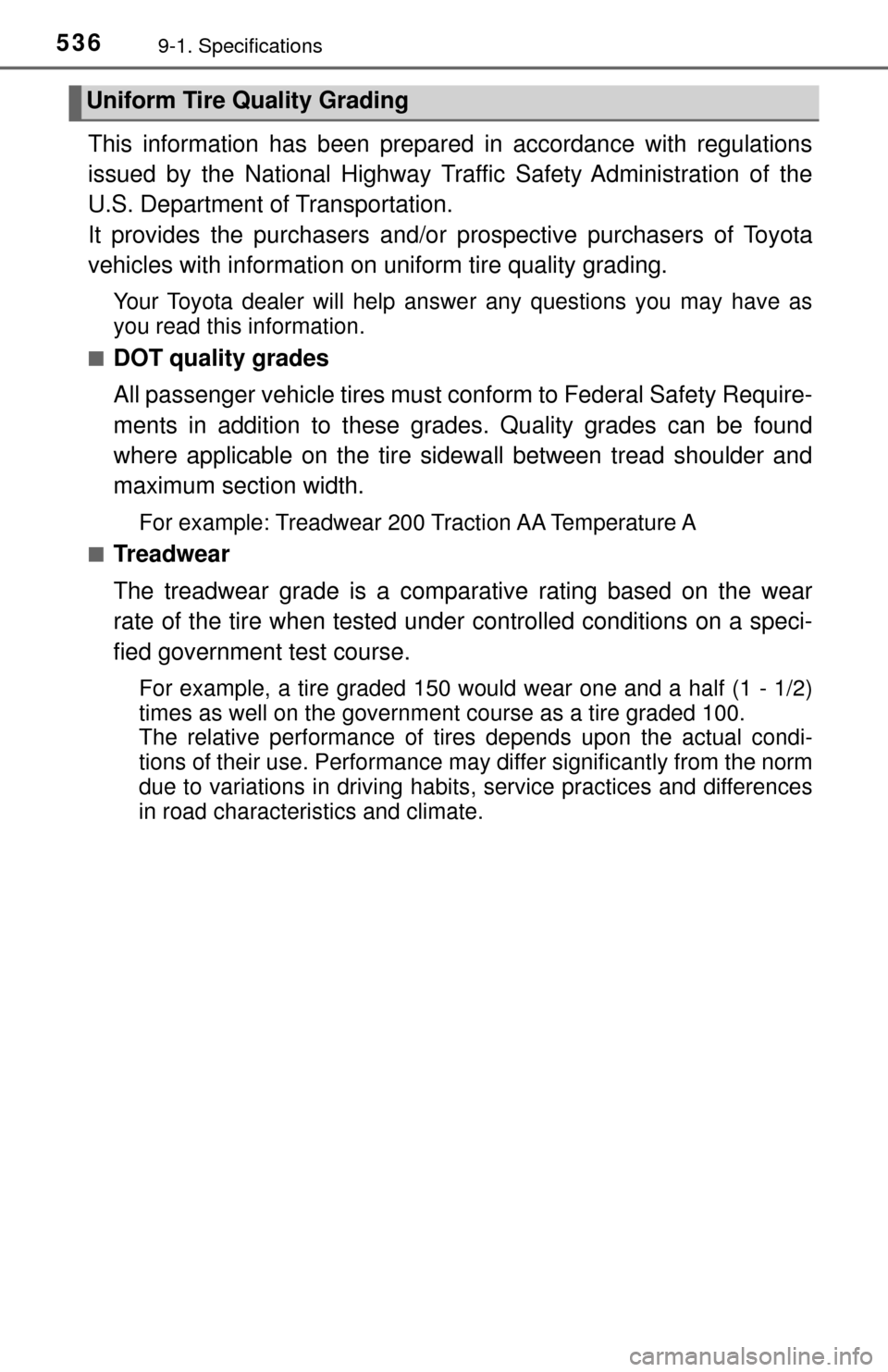
5369-1. Specifications
This information has been prepared in accordance with regulations
issued by the National Highway Traffic Safety Administration of the
U.S. Department of Transportation.
It provides the purchasers and/or prospective purchasers of Toyota
vehicles with information on uniform tire quality grading.
Your Toyota dealer will help answe r any questions you may have as
you read this information.
■DOT quality grades
All passenger vehicle tires must c onform to Federal Safety Require-
ments in addition to these grades. Quality grades can be found
where applicable on the tire sidewall between tread shoulder and
maximum section width.
For example: Treadwear 200 Traction AA Temperature A
■Treadwear
The treadwear grade is a comparative rating based on the wear
rate of the tire when tested under controlled conditions on a speci-
fied government test course.
For example, a tire graded 150 wo uld wear one and a half (1 - 1/2)
times as well on the government course as a tire graded 100.
The relative performance of tire s depends upon the actual condi-
tions of their use. Performance may differ significantly from the norm
due to variations in driving habits, service practices and differences
in road characteristics and climate.
Uniform Tire Quality Grading